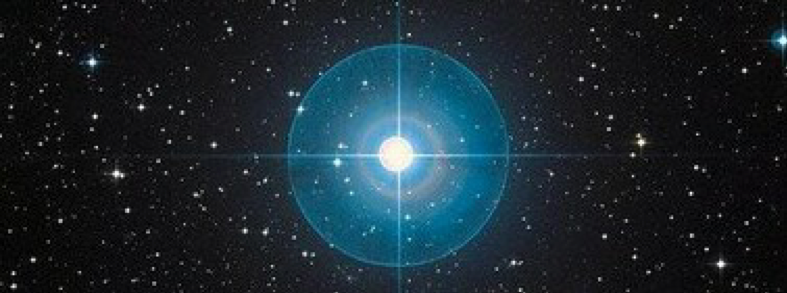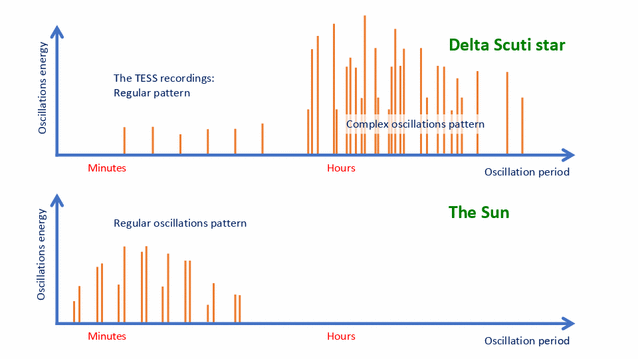The variable delta Scuti stars reveal some of their secrets
Danish National Research Foundation centre in Aarhus has a central role in some newly discovered details of the remarkable delta Scuti stars. To be published in Nature Wednesday 13. May

Using observations from the NASA TESS satellite an international group of researchers with strong representation from Stellar Astrophysics Centre at Aarhus University has been studying 60 stars of the variable class named after the star delta Scuti in the constellation Scutum - the Shield. Until now this class of stars has evaded precise determinations of their parameters because they vibrate in a very complex way making research on them difficult.
The astronomers study the regular oscillations in these vibrating stars. A star will vibrate like a bell, and like the seismologists study the inside of the Earth by observing waves caused by detonations and earth quakes, the astronomers likewise can "look" into the stars by studying the vibrations observed on the surface of the stars. The technique has been named "asteroseismology".
Even though the delta Scuti stars in many ways behave like the Sun, the paper in Nature documents the first analysis by the asteroseismologists determining regular patterns of oscillation frequencies in this type of stars. These regular patterns of oscillations now make it possible to compare the observed frequencies to theoretical predictions, enabling the astronomers to learn more about the properties of these stars. This will impact our understanding of how stars are working and how they develop over time.

n the Sun the oscillation frequencies have periods lasting minutes. In a typical delta Scuti Star the periods are hours long, but the TESS satellite has discovered other much shorter Sun-like oscillations. The height of the orange "pins" shows how much energy each oscillation contains. Illustration: HK/SAC/AU.
Satellites like for instance NASA's TESS study the stars by measuring tiny variations in the brightness simultaneously for tens of thousands of stars over several weeks. Looking at the patterns of oscillations for an ordinary "well behaved" star like our Sun or one of the red-giant stars, it will look nice and regular like a cardiogram from a healthy heart. The patterns shown by most delta Scuti stars would have the heart surgeon start on an immediate procedure! In the Nature paper the researchers have found 60 out of the thousands of delta Scuti stars observed by TESS to have some common traits. They show regular similarities in the oscillations, and not only that, but these oscillations resemble those well known from the Sun. This places the astronomers on solid ground:
Professor Jørgen Christensen-Dalsgaard, Aarhus University, who is not a co-author to the paper, is excited: "Now we can begin to look at the inner relationships of these variable stars, and thus learn even more of the details in the stars under these special circumstances. We all become the wiser, also in the knowledge of how our more well-behaved Sun operate, and why it is so relatively quiet and stable - teaching us also more about our place in the Universe."
Co-author Professor Hans Kjeldsen, Aarhus University, adds: “The new results can amongst other things be used to determine the ages of groups of stars that come in clusters and in stellar streams - stars lumping together, not yet having learned the rules of social distancing!"
The lead author of the new paper in Nature is Professor Tim Bedding, leading the SAC node in Sydney, and a frequent guest at Aarhus University. Professor Bedding comments: “Previously we were finding too many jumbled up notes to understand these pulsating stars properly. It was a mess, like listening to a cat walking on a piano.” He continues: “The incredibly precise data from NASA’s TESS mission have allowed us to cut through the noise. Now we can detect structure, more like listening to nice chords being played on the piano.”
Co-author Dr. Victoria Antoci, who is now a Senior Researcher at DTU Space but was a researcher at SAC in Aarhus for 8 years supplements: “These results are fantastic and very important and will allow us to better understand the mechanism driving these pulsations, something that evaded us for 120 years (since the first delta Scuti star was detected).”
Stellar Astrophysics Centre (SAC) is founded by the Danish National Research Foundation, and at SAC in Aarhus several of the astronomers are working on asteroseismology. The Aarhus group is the hub of a larger network of national and international co-workers; the "nodes". The centre director is professor Jørgen Christensen-Dalsgaard; one of the pioneers in helio- and asteroseismology. The Nature paper has several co-authors from Aarhus and other researches affiliated to the Danish centre among the 35 authors from 24 research institutions in 10 countries.
The observations gathered with satellites like TESS are transmitted to Stellar Astrophysics Centre at Aarhus University. Here the raw data are prepared for further work and are made accessible to the many astronomers all over the World interested in the inner structure of stars. In this way SAC has for the last eight years had a central international role in this research field.
What is a delta Scuti-star?
Very many of the stars in the sky vary in brightness of many different reasons. In a certain transitional phase of their life and development most stars will start to vary. In the atmospheres of the delta Scuti stars the element helium is relatively abundant, and helium is the dominant factor in the variability of these stars. Heated by the energy from the stellar interior helium will ionize - i.e. it will loose some of its electrons. Cool helium is opaque, not letting the starlight pass through out into space. This trapped light energy will heat helium and the rest of the stellar atmosphere, making it expand, ionize and become more transparent. The energy will then get away, making the star look brighter. But with this loss of energy the outer layers of the star will cool down, causing helium to again become opaque - and the process can start all over again: the star pulsates.
Delta Scuti was the first to be discovered, giving name to this whole group of stars. You can find the star in the constellation Scutum - The Shield near the constellation Aquila in the Summer sky. It will just about be visible on a dark and clear night to the naked eye. Seeing that it is a variable requires instruments, though. It's magnitude will vary less than 20% over a period of a bit more than 4 1/2 hours. The nearby much brighter star Altair in Aquila and also Denebola in Leo are much better known delta Scuti stars.
Swingin' on a Star
Our Sun and all other stars oscillate like gigantic bells, and the oscillations cause tiny variations in the total brightness of the star. These variations are extremely difficult to measure from the surface of the Earth, being so small, so the measurements will have to be done from satellites like e.g. CoRot, Kepler and TESS outside the atmosphere. The varying light curve of the star can be transformed into a set of oscillation frequencies, like the overtones in a musical instrument. These frequencies characterize the physical relations in the star, all the way to it's central parts. This way the asteroseismologists can see processes taking place deep in the inaccessible parts of the star, obtaining knowledge of many of the basic parameters for the stars. The oscillations do not tell the full story, though. Total knowledge also requires information on the stellar surface temperature and the metallicity of the star. Her Earth based observations can help. All together it gives us knowledge of the ages and sizes and several other physical characteristics of a given star.
The paper in Nature is available at this link
More on Stellar Astrophysics Centre here
DOWNLOAD animation showing the pulsating delta Scuti-star HD 31901 with sound file at this link.
Background material from NASA:
YouTube-vido on the TESS satellitte on this link.
(Aarhus University is closed down at present, but we are working at home and can be contacted)
Professor Hans Kjeldsen hans@phys.au.dk
Professor Jørgen Christensen-Dalsgaard jcd@phys.au.dk
Dr. Victoria Antoci antoci@space.dtu.dk
